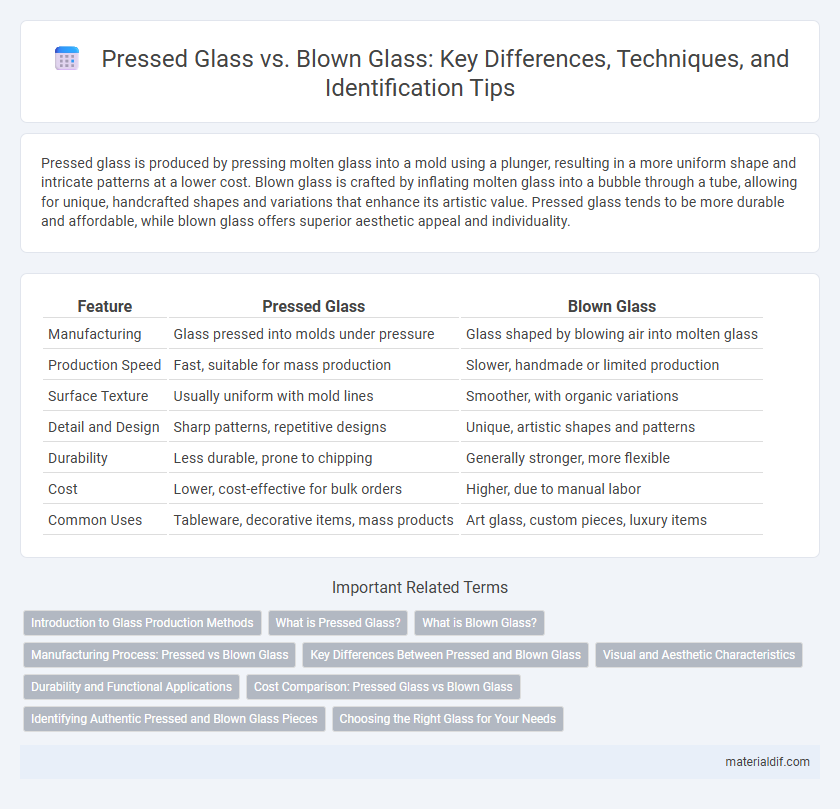Pressed glass is produced by pressing molten glass into a mold using a plunger, resulting in a more uniform shape and intricate patterns at a lower cost. Blown glass is crafted by inflating molten glass into a bubble through a tube, allowing for unique, handcrafted shapes and variations that enhance its artistic value. Pressed glass tends to be more durable and affordable, while blown glass offers superior aesthetic appeal and individuality.
Table of Comparison
| Feature | Pressed Glass | Blown Glass |
|---|---|---|
| Manufacturing | Glass pressed into molds under pressure | Glass shaped by blowing air into molten glass |
| Production Speed | Fast, suitable for mass production | Slower, handmade or limited production |
| Surface Texture | Usually uniform with mold lines | Smoother, with organic variations |
| Detail and Design | Sharp patterns, repetitive designs | Unique, artistic shapes and patterns |
| Durability | Less durable, prone to chipping | Generally stronger, more flexible |
| Cost | Lower, cost-effective for bulk orders | Higher, due to manual labor |
| Common Uses | Tableware, decorative items, mass products | Art glass, custom pieces, luxury items |
Introduction to Glass Production Methods
Pressed glass is created by pressing molten glass into a mold using a plunger, resulting in detailed patterns and consistent thickness, ideal for mass production. Blown glass involves inflating molten glass into a bubble using a blowpipe, allowing for handcrafted, unique shapes with variable thickness. Both methods rely on heating silica-based materials, but pressed glass emphasizes precision and repeatability, while blown glass prioritizes artistic expression and individuality.
What is Pressed Glass?
Pressed glass is a type of glassware produced by pressing molten glass into a mold using a plunger, allowing for intricate patterns and shapes with consistent thickness. This method enables mass production of detailed designs at lower costs compared to blown glass, which is shaped by manually inflating molten glass. Pressed glass typically exhibits more uniformity and sharp-edged patterns, making it popular for decorative and functional items such as tableware and decorative panels.
What is Blown Glass?
Blown glass is a type of glassware created by inflating molten glass into a bubble using a blowpipe, allowing artisans to form intricate shapes and designs with unique variations. This technique, dating back thousands of years, produces lightweight and often delicate pieces with a distinct, organic texture compared to the uniformity of pressed glass. Blown glass is prized for its craftsmanship and artistic value, often featuring swirling patterns and air bubbles that enhance its aesthetic appeal.
Manufacturing Process: Pressed vs Blown Glass
Pressed glass manufacturing involves pouring molten glass into a mold and then pressing it with a plunger to create intricate patterns, resulting in uniform, mass-produced pieces with consistent thickness. Blown glass is handcrafted by inflating molten glass into a bubble using a blowpipe, allowing for more artistic shapes, variations in thickness, and unique, one-of-a-kind designs. The pressed glass process is faster and more cost-effective for large quantities, while blown glass requires skilled artisans and longer production times, emphasizing craftsmanship.
Key Differences Between Pressed and Blown Glass
Pressed glass is created by pressing molten glass into a mold using a plunger, resulting in uniform shapes and intricate patterns ideal for mass production. Blown glass is formed by inflating molten glass into a bubble and shaping it by hand, allowing for unique, artistic, and often asymmetrical designs with varying thickness. Key differences include production techniques, level of detail, consistency, and typical uses, with pressed glass favored for affordability and precision, while blown glass is prized for craftsmanship and individuality.
Visual and Aesthetic Characteristics
Pressed glass features uniform patterns and precise details due to its mold-based production, resulting in a consistent texture and thickness that enhances clarity and brilliance. Blown glass displays organic shapes, varied thickness, and subtle imperfections, giving it a unique, artisanal aesthetic with dynamic light refraction. The choice between pressed and blown glass directly influences the visual appeal, with pressed glass offering polished symmetry and blown glass providing artistic individuality.
Durability and Functional Applications
Pressed glass exhibits greater durability due to its uniform thickness and solid structure, making it ideal for everyday functional applications like dinnerware and storage containers. Blown glass, characterized by its variable thickness and delicate form, suits decorative purposes and artistic displays but is less resilient to impact and thermal stress. The choice between pressed and blown glass depends on the required strength and practical use, with pressed glass favored for durability and repeated handling.
Cost Comparison: Pressed Glass vs Blown Glass
Pressed glass generally costs less than blown glass due to automated production methods that reduce labor and time. Blown glass involves skilled craftsmanship and longer production times, increasing its price significantly. The cost difference is reflected in the affordability of mass-produced pressed glass items compared to the unique, artisanal nature of blown glass pieces.
Identifying Authentic Pressed and Blown Glass Pieces
Authentic pressed glass pieces often display visible mold seams and uniform patterns resulting from the mechanical pressing process, while blown glass typically features irregularities and pontil marks indicating handcrafting. Identifying pressed glass involves examining the consistent thickness and sharp-edged designs, whereas blown glass reveals subtle variations in shape and thickness due to its manual formation. Both types can be verified by weight, clarity, and detail sharpness, with pressed glass generally heavier and more precise in pattern replication.
Choosing the Right Glass for Your Needs
Pressed glass offers uniform thickness and intricate patterns ideal for decorative tableware and mass production, providing durability and affordability. Blown glass, crafted by skilled artisans, delivers unique shapes and variations perfect for bespoke vases and art pieces requiring a delicate aesthetic. Selecting the right glass depends on the desired design complexity, production scale, and functional requirements such as strength or transparency.
Pressed glass vs Blown glass Infographic

 materialdif.com
materialdif.com